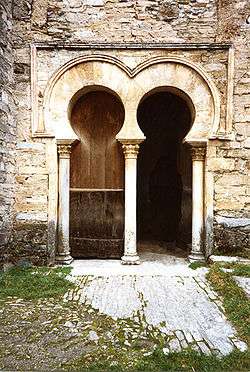Santiago de Peñalba


The Mozarabic church of Santiago de Peñalbais located in the Valle del Silencio (Valley of Silence) in the region of El Bierzo, province of León, Community of Castile and León, Spain.
The Valle del Silencio is known as "La Tebaida Berciana" (the Bercian Thebaid) due to the abundance of sanctuaries and monasteries, dating to the 8th century.
History
Abbot Salomón promoted the construction of the church in the first half of the 10th century, a time of prosperity in the Kingdom of León. It was completed in the reign of Ramiro II, who expanded the limits of his kingdom beyond the Duero River. Ramiro II made multiple donations to the church and the monastery.
One of those donations, made to the Bishopric of Astorga, was the so-called Cruz de Peñalba (Cross of Peñalba), a symbol of El Bierzo's comarca. This cross is an example of Visigothic gold work, influenced by Mozarabic models.
Architecture
The church is characterized by opposed apses, an unusual feature shared with the tenth-century church of San Cebrián de Mazote (also constructed during the apogee of the Kingdom of León).
The church's decoration is a mixture of Celtic elements, including lunar and astral symbols; Byzantine influences seen in its Greek-cross plant; Arab elements, especially a small umbrella roof dome which covers the principal altar; and Mozarabic influence, seen in its famous horseshoe arches.
| Wikimedia Commons has media related to Santiago de Peñalba. |
External links
Coordinates: 42°25′38″N 6°32′27″W / 42.4272°N 6.54083°W